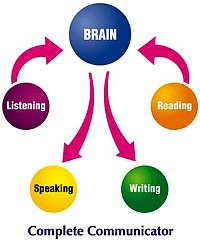 |
Learn English Locally, Apply It Worldwide! Enjoy Regular Practice |
Figures of Speech
We deal with figures of speech in all languages, in order to 'transport' meaning from our mind through the words we're using, to the ear of the listener or to the readers of our pages.
Mainly three figures of speech are among the most widely used. We shall look at these three and measure their potential for the writer.
The metaphor
Of all, the metaphor is the most powerful. Here the writer doesn't liken one thing to another. He simply takes the identity of one thing and imprints it on another - and so he penetrates magic. A bit like "the princess of the night raised her pale face over the peak of the mountain and lit the whole garden in front of the palace." Our princess here is the moon, you will soon realise.
The simile
The simile does liken, and for this very reason it seems somehow to be weaker. One is made aware of the device, and so it becomes self-conscious. Its danger is that it tends to be 'arty' or artificial. Just how good is:
"O my luve is like a red, red rose,
That's newly sprung in June..."
Personification
With personification again the writer can make the abstract appear tangible and familiar. Maybe the secret lies in what Blake tells us - that
Cruelty has a Human Heart
And Jealousy a Human Face ... etc.
We shall take them one by one and consider their magic in more details in our future lessons. Until then, try to find them in your reading and recognise them in your own time. Familiarize yourselves with spotting them for now.
English Corner Weekly E-zine
Packed with knowledge, published on Tuesdays.
Get yours here!
Our Archives:
Our lessons in the names and sounds of letters, short & long vowel sounds, CVCs, CCVCs, CVCCs, sight words, vowel and consonant contrasts, etc.
Our lessons will help increase your vocabulary, word recognition, find meaning in context, skills for TOEFL tests and other games, for fun.
Here we shall build some lessons to help you improve your writing skills.
Lots of lessons: cause & effect, comparisons, linking signals, relative clauses, presenting information, expressing emotions and grammar games, of course. We had more lessons on: intensifying adverbs and phrasal verbs, expressing various concepts such as addition, exception, restriction and ambiguity. Lately we started some exercises: likes/dislikes, frequency adverbs (twice), verb tenses, etc.
Learn how to build a website, by using the SBI! system - start from the basics, developing a site concept and a niche, supply and demand, learn about profitability and monetization, payment processing, register domain, website structure and content as a pyramid. Also learn about the tools I'm using to build this website. We also covered how to build traffic, working with search engines, building a good system of inbound links, using social marketing and blogs with the SBI system, how to use Socialize It and Form Build It, how to publish an e-zine and how to build a social network in your niche.
We looked at a few games by now: Countable & uncountable nouns, Free Rice, Name That Thing, Spell It, Spelloween, the Phrasal Verbs Game, Preposition Desert, The Sentence Game, Word Confusion, Word Wangling, Buzzing Bees, and The Verb Viper Game.
Be prepared to play and learn more pretty soon.
